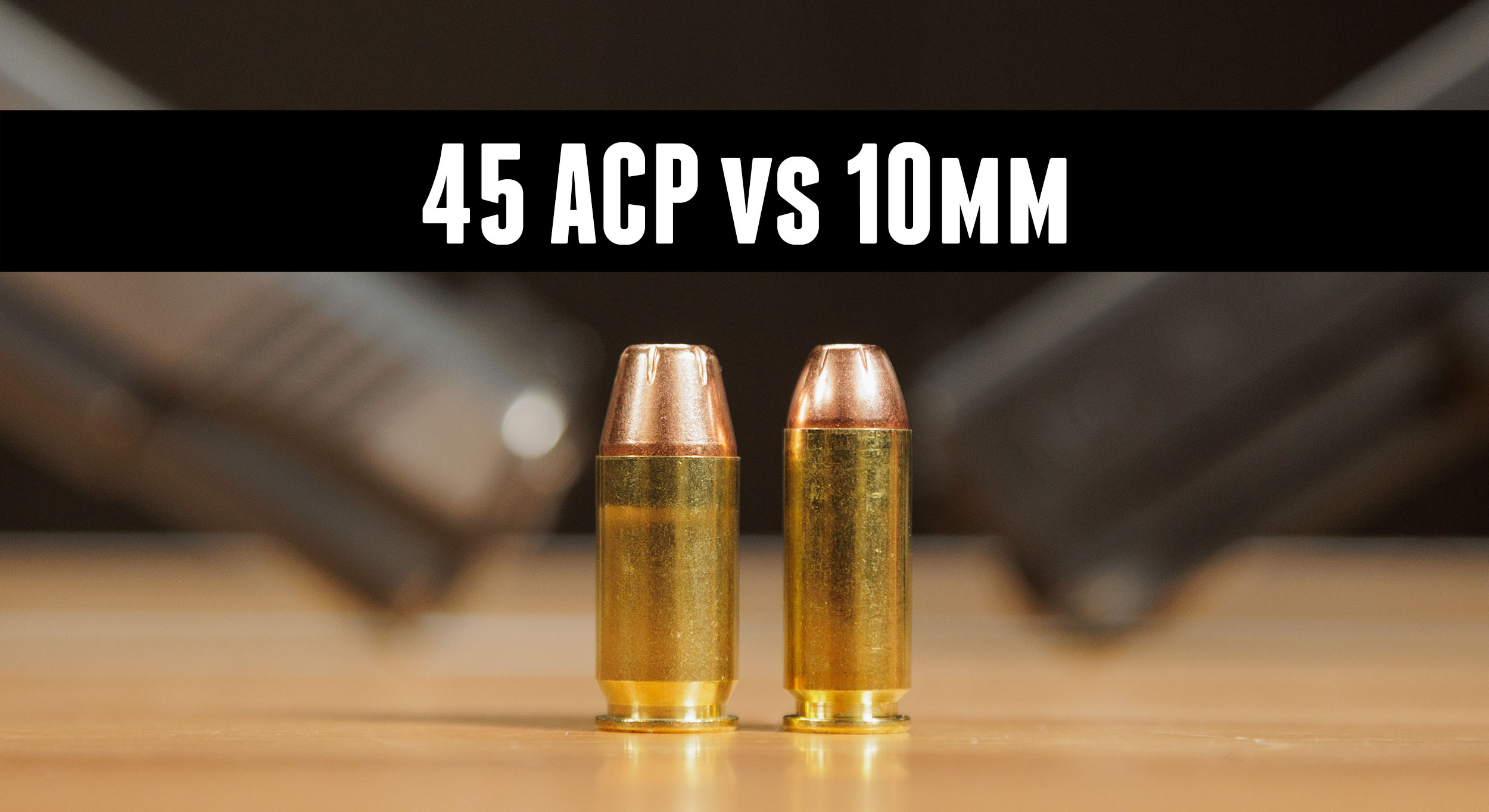10mm and .45 ACP are the heavy hitters of the self-defense handgun world. Which is better?
Disclaimer
Ultimate Reloader LLC / Making with Metal Disclaimer: (by reading this article and/or watching video content you accept these terms). The content on this website (including videos, articles, ammunition reloading data, technical articles, gunsmithing and other information) is for demonstration purposes only. Do not attempt any of the processes or procedures shown or described on this website. All gunsmithing procedures should be carried out by a qualified and licensed gunsmith at their own risk. Do not attempt to repair or modify any firearms based on information on this website. Ultimate Reloader, LLC and Making With Metal can not be held liable for property or personal damage due to viewers/readers of this website performing activities, procedures, techniques, or practices described in whole or part on this website. By accepting these terms, you agree that you alone are solely responsible for your own safety and property as it pertains to activities, procedures, techniques, or practices described in whole or part on this website.
Handguns for Self-Defense: A Brief History
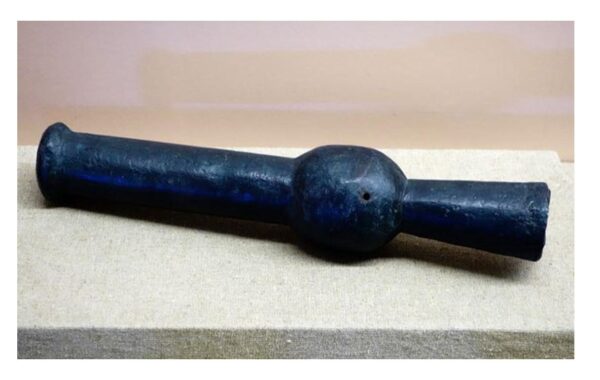
The history of firearms goes back several centuries and they have been used for fighting from the very beginning. (The Chinese have an early gun dating to 1288!) Handguns were quickly discovered to be an excellent weapon for mounted cavalry and many countries equipped their forces with the classic sword and pistol combination. Interestingly, the sword was often considered the primary weapon!

Traditional muzzleloading handguns came first, but things improved considerably with the advent of the revolver. Colt started producing percussion revolvers in the 1840s. By 1860, they had become well known and popular. Officers from both North and South wore revolvers during the Civil War. Many preferred the smaller Colt “pocket” revolver as it was small, lightweight and easy to carry — exactly the same reasons today’s carry guns tend to be small and lightweight.
The next big step was the introduction of metallic cartridges. This made the revolver much faster to load and improved reliability. The Army adopted the famous Colt Single Action Army and the .45 Colt cartridge in 1873. This sidearm quickly established a great reputation. Colt Single Action revolvers were sometimes referred to as “The Equalizer,” as the user was capable of defending himself/herself or protecting his/her family against larger, stronger opponents.
Double-action revolvers soon followed and to this day are beloved for self-defense. They offer the advantage of only needing the trigger to be pulled to operate, and are fast to reload. By the mid 1890s, semi-automatic pistols were in production. The U.S. Army adopted the .45 ACP 1911 in 1911. Interestingly, the 1911 proved more reliable than revolvers in Army tests! Revolver and semi-automatic handgun designs improved throughout the twentieth century and their use became widespread by military, law enforcement, and private citizens.
Handguns for Self-Defense: Considerations
I cannot overemphasize the importance of proper training! Owning and using a firearm for self-defense is a heavy responsibility not to be taken lightly. Your life and the lives of others as well as your freedom could be at risk. Learn when, why, and how to lawfully use a firearm from a good instructor. There are a number of nationally known firearms training schools as well as many smaller training businesses. Seek one that has experienced, certified, and insured instructors. There is much more to self-defense than just pulling the trigger—it’s fighting, but with a handgun. Fighting for your life, your family, and to protect others. Learn it well. I truly believe that the skills are far more important than our choice of a particular firearm or ammunition. One of the most important things to learn is when to use a firearm defensively, and when not to.
Several things should be considered when selecting a handgun for self-defense. The physical size of the handgun is of extreme importance. Handguns range from downright tiny to monstrous. A smaller handgun is easier to conceal, but they can be difficult to shoot well. The short sight radius, small grip, and lack of weight all conspire against accurate shooting. Also many smaller handguns have only rudimentary sights, making accuracy difficult.
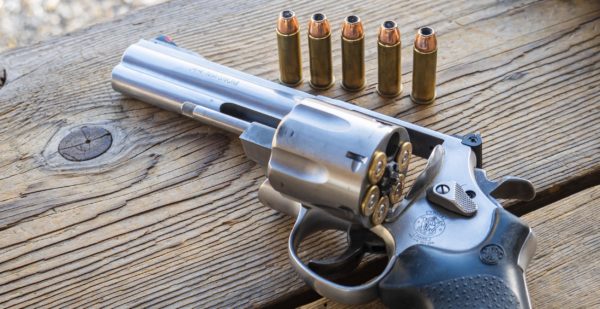
On the other hand, a particularly large handgun, whether a revolver or semi-automatic, can be excessively heavy and bulky for concealed carry. The bigger guns typically offer a bigger, more comfortable grip, a longer sight radius, more weight to offset the recoil, and often much better sights. All that adds up to a gun that is easier to shoot well, as long as the power of the cartridge can be handled. If the handgun isn’t going to be concealed, then size is less important — for instance, if it’s a “nightstand gun” or kept at home or work for protection. Even a larger handgun can be concealed with a good holster and dressing to accommodate the gun.
My personal handguns range in size from a diminutive 14 ounce Kahr CM9, to a 45 ounce S&W 629. I have carried the 629 concealed under a vest or a jacket, but far more often I rely on smaller, lighter handguns for concealed carry. It’s just easier.
How powerful should a handgun for self defense be? I urge people to use as powerful a firearm as they can handle well. No sense just sending love-taps at an assailant rather than thunderbolts! Assuming the shooter can handle the thunderbolt…
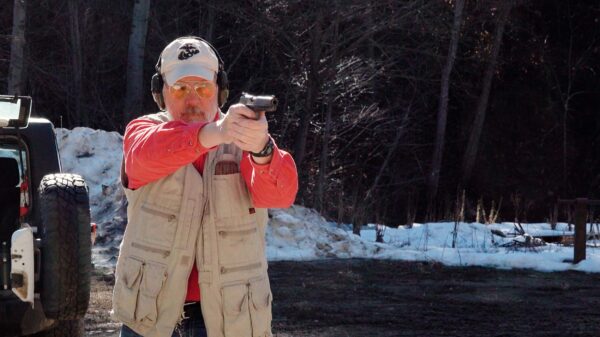
If all else is equal, both guns are the same weight, and both are equally comfortable to grip, then the more powerful gun is going to recoil more. It’s physics. For example, a 9mm 1911 produces far less recoil than a nearly identical 1911 in the powerful 10mm cartridge. The 9mm is easier to shoot well, and offers enough power for most self-defense situations.
Consider your likely threat. If it’s an urban criminal, “normal” cartridges such as the .38 Special and 9mm Luger are likely adequate. If aggressive, large animals like bears are anticipated, then a more powerful firearm with heavier bullets is a better choice.
All things considered, the best “stopping power” is produced by excellent shot placement.
That’s worth reading again. Good hits from a modestly powerful handgun are much more effective than misses or poor hits from a very powerful handgun.
Another big decision is between revolvers and semi-automatic handguns. Regardless of what some say, revolvers are still pertinent for self defense. They’re simple to operate and often less intimidating for inexperienced shooters. They can be both powerful and accurate. The only real drawback to using a revolver for self defense is that they typically have a rather limited ammunition capacity, usually 5 or 6 shots. Reloading a revolver also tends to be a bit slower than reloading a semi-automatic.
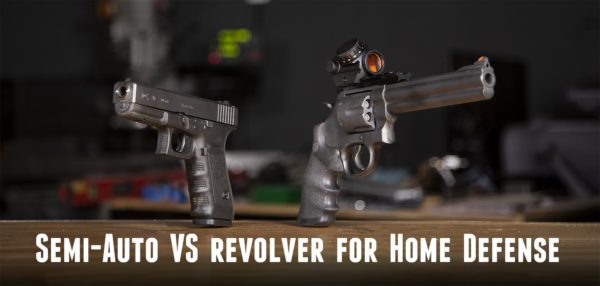
Semi-automatic pistols can be more difficult to master: loading magazines, dealing with safeties and decockers, operating the slide, dealing with flying brass, etc. All that can add up to a rough experience for a novice or infrequent shooter. On the other hand, once mastered, semi-automatics can be both fast and accurate as well as safe to use. Some semi-autos are far more complicated to operate than others.
History of the .45 ACP
One of my favorite handgun cartridges is the classic ,45 ACP (Automatic Colt Pistol). The old big-bore has a long standing reputation as an excellent manstopper. The cartridge and original firearms for it were designed by John Moses Browning, leading 1911 owners to sometimes quip that their .45’s were given to mankind by Moses!
The initial model was put into production in 1905, and launched a 200 grain bullet at 900 fps. The Army demanded some changes to both the pistol and cartridge and in 1911 adopted the new pistol, now firing a 230 grain bullet at 820 to 840 fps.
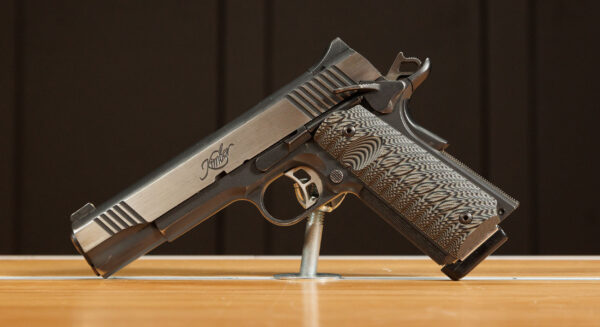
The power level, bore diameter, and bullet weight were inspired by decades of successful use of the older .45 Colt revolver cartridge. The .45 Colt had served our military, lawmen, and private citizens well since its 1873 introduction. The Army wanted similar performance, but in a modern, semi-automatic pistol. American military experiences in the Philippines had proven the .38 Long Colt inadequate for stopping assailants, and the Army wanted to return to a more powerful, larger bore cartridge.
Since the Army’s adoption of the 1911, the .45 ACP cartridge has become very popular with lawmen and private citizens alike. It’s chambered in a wide variety of handguns, and is produced in a wide range of bullet weights, types, and velocities. The .45 ACP has a MAP (maximum average pressure) of 21,000 psi, which is fairly low. A few ammunition companies produce 45+P ammunition, limited to 23,000 psi, that produces increased muzzle velocity. Today’s .45 ACP ammunition typically delivers a muzzle velocity between 780 and 1170 fps.
History of the 10mm
An early proponent of the 10mm cartridge was Colonel Jeff Cooper who thought that a handgun delivering a 200 grain bullet at 1200 fps would be advantageous, particularly at longer handgun ranges. The 10mm debuted in the 1980s with the ill-fated Bren Ten by Dornaus & Dixon. Sadly that pistol and the company didn’t last long. The initial ammunition was produced by Norma and was quite powerful, sending a 200 grain bullet downrange at 1200 fps, exactly what Colonel Cooper desired! The cartridge has a MAP of 37,500 psi, far greater than used by the .45 ACP. This pressure allows it to develop the high muzzle velocity that the 10mm is known for.
Colt and other manufacturers took note of the new cartridge and soon other 10mm pistols were in production. Smith and Wesson produced the 1076 and related 1006. Colt came out with the Delta Elite, based on their 1911.
In 1986, the law enforcement world was rocked by a disastrous gunfight in Miami. Two FBI agents were killed and several others wounded by a pair of well-armed violent criminals. Agent Mirales emerged as a hero for finishing the fight with his revolver. As a result of the gunfight, the FBI concluded that their 9mm pistol was inadequate and decided that a semi-auto 10mm pistol was the best cartridge for their purposes.
The FBI bought Smith and Wesson 10mm pistols and other law enforcement agencies followed their lead. Sadly, the 10mm didn’t last long as a law enforcement cartridge. It offered plenty of power, but at the cost of delivering plenty of recoil to the shooter. Agencies learned that it took a great deal of training time for some officers to master the powerful handgun and the FBI asked manufacturers to come up with a lighter recoiling load for the 10mm. The “FBI load” featured a 180 grain bullet at about 1,000 fps. The ammo makers took a look at that and realized that a shorter cartridge could provide that level of ballistics, and the .40 S&W was born.
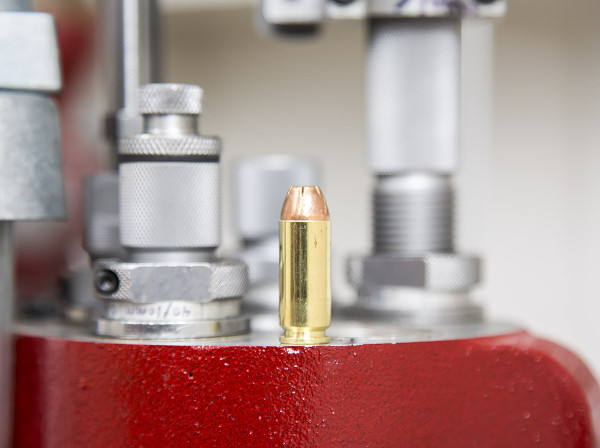
The 10mm has enjoyed increased popularity in recent years, particularly with outdoorsmen. Hunters, anglers, and people venturing into areas where grizzly bears and other large and dangerous wildlife exist are particularly attracted to it. The 10mm semi-auto is seen as offering near magnum ballistics in a reasonably compact firearm with more ammunition than a revolver. Perhaps the most popular 10mm is the GLOCK 20— a full size pistol with the same size frame and slide as the .45 ACP GLOCK 21.
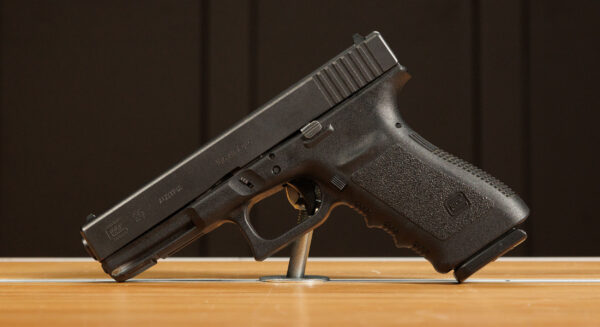
The double stack GLOCK 20 has a 15-round magazine capacity, is virtually weatherproof, and recoils far less than a comparably sized .44 magnum revolver. A number of manufacturers now offer the 10mm in a 1911 platform, which has enhanced its popularity.
Ballistics
Though both cartridges are powerful options, it’s obvious from the specifications why the 10mm produces significantly more velocity and energy than the older .45 ACP.
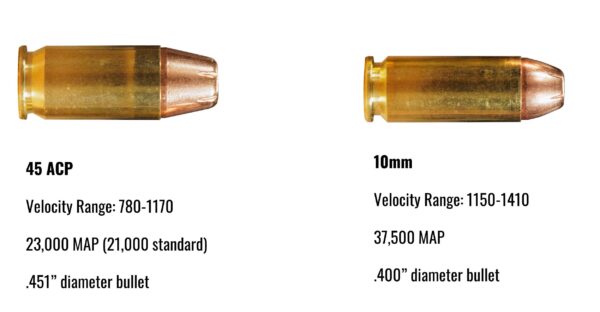
The below ballistics were taken from what Hornady offers in their wide selection of 10mm and .45 ACP commercial ammunition. I wanted to standardize on the Hornady XTP bullet for all of these tests as it’s been available for a long time and has earned an excellent reputation for accuracy and performance on target. I also wanted to sample a light bullet load and a heavy bullet load for each caliber. The velocity differences are impressive and only start the tale.
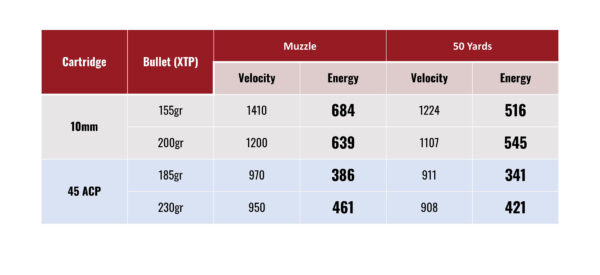
For a defensive handgun though, I think a more compelling figure is the ft.-lbs. of energy developed by each. Energy is a useful tool for comparing cartridges. It’s notable that even at 50 yards, both types of 10mm ammunition still have more power than either of the .45 loads do at the muzzle!
Common Self-Defense .45 ACP and 10mm Ammo Types
Perusing the available self-defense ammunition for each cartridge, I was pleased to note that all the major manufacturers offer worthwhile choices. Going through our local gun shops, I noted that while a variety of .45 ACP ammo was available, far less 10mm was on hand. 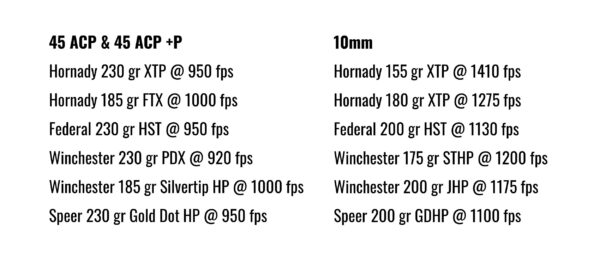
Costs
It’s well worth noting that both the .45 ACP and the 10mm are expensive to feed! .45 ACP runs between $1.10 and $1.32 per round while 10mm is between $1.05 and $1.25 per round. Self-defense handgun ammo is expensive to produce, which is reflected in the pricing. Factory self-defense ammo often features nickel-plated cases, sealed primers, special flash-reducing powders, and an advanced bullet design intended to do well in FBI testing protocols. All that costs money. This is why so much self-defense ammunition is offered only in 20-round boxes—to keep the costs down.
As shooters, we have a couple ways to beat those high costs for our practice ammo. We can buy less expensive FMJ ammunition in bulk, seriously undercutting the price of the premium self-defense ammo, or we can handload.
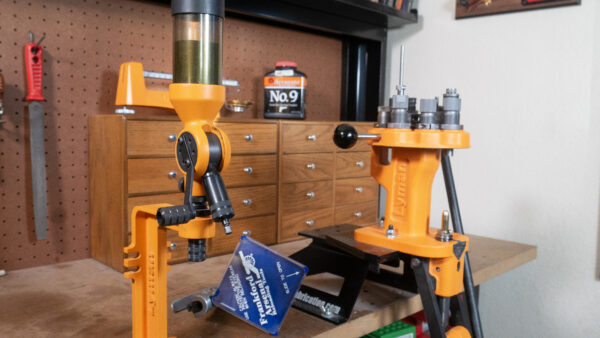
If I included the cost of the brass cartridge case, my handloads for all four types I assembled averaged about $0.75 cents each. The brass case can be reloaded many times so it becomes much cheaper to load and shoot with reuse.
Some people object that “time is money” and figure in that cost per hour. I enjoy loading my own ammunition, it’s part of my shooting hobby and always has been. By loading my own ammunition, I also feel I get to know its characteristics better. So, for me personally, there’s no real cost in the time spent handloading—it’s just pleasure for me.
About the Loads
Using handloads for self-defense is a controversial subject. Some argue that assembling your own handloads puts an individual more at risk in both criminal and civil trials after a shooting. Even in a justified shooting, a civil suit is likely. Others say that the use of handloads poses no legal risks. It pays to research the subject and make your own decision. I prefer to use factory loads for my carry guns, in part because of the low-flash additives to the powder used by many manufacturers. Commercial self-defense ammo is held to high standards, but there can still be ammo failures even with ostensibly high-quality commercial ammunition.
Introduced in the late 1980s, Hornady’s XTP (eXtreme Terminal Performance) bullet has earned a great reputation as a self-defense bullet and also for hunting medium-size game. I chose to use XTP bullets across the board for this comparison. In earlier testing I found that the 10mm 200 grain XTP penetrated 20” into our clear ballistics gel blocks, expanded to .531” diameter and retained 197.5 grains of bullet weight. That’s impressive performance!
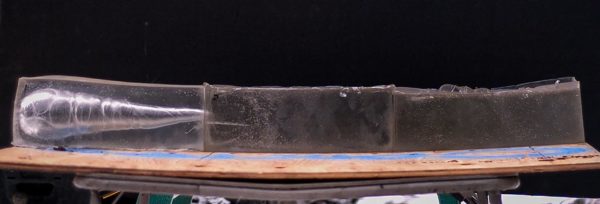
I loaded the 10mm with 155 grain Hornady XTP’s, 200 grain Hornady XTP’s, and Accurate No. 9 on a Lyman Brass Smith Turret Press. I loaded the .45 ACP+P with 185 grain and 230 grain Hornady XTP’s and Ramshot Silhouette. All loads used CCI large pistol primers.
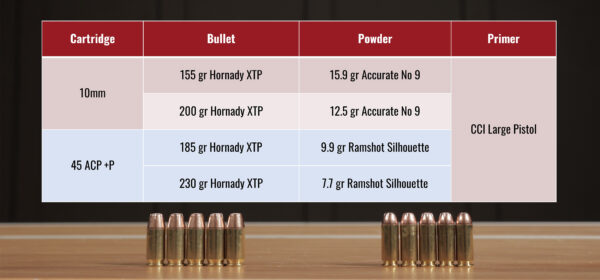
Note that these are MAXIMUM LOADS. The data came from Hodgdon’s Reloading Data Center. The .45 ACP+P loads are at the top for each bullet weight as are both 10mm loads. Please work up carefully to the level where you are comfortable and safe. Do NOT exceed published load data.
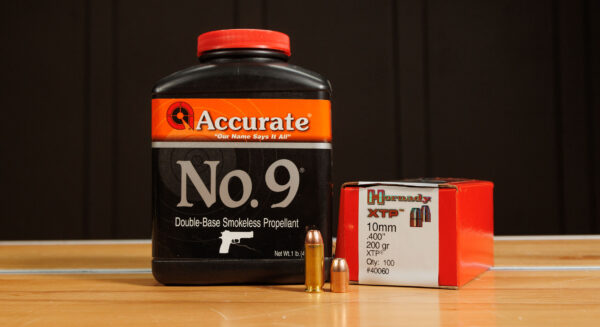
I’ve previously used Accurate No.9 in the .44 magnum, .45 Colt (Ruger level loads), and .500 S&W magnum handguns. This powder is always a pleasure to work with as it meters easily and accurately from a manually-operated powder measure, making it ideal for use with a progressive press or powder drop. (I had great success with the Lyman Brass Smith Powder Measure.) Hodgdon’s data indicated a 14.3 starting load and 15.9 grain maximum load for the 10mm 155 grain XTP and 11.3 grains to start with a 12.5 grain maximum with the 200 grain XTP. (Note: Hodgdon’s data is from a 5” barrel whereas the GLOCK 20 has a slightly shorter 4.61” barrel. A small loss of velocity was anticipated and observed.)
We had not yet used Ramshot Silhouette for any of our handloading and it appeared to be a great choice for +P level .45 ACP loads using both 185 and 230 grain bullets. The old 230 grain bullet weight is still the most popular and traditional choice, but the lighter bullets with their higher velocities are well-suited for self defense.
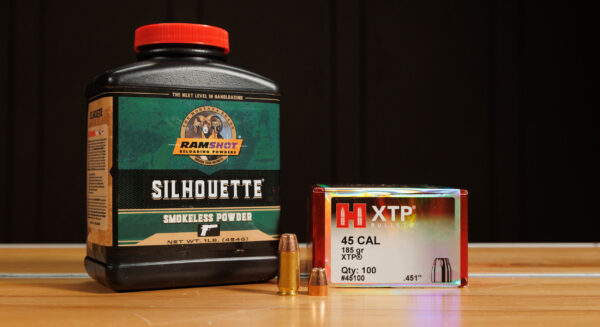
Hodgdon’s .45 ACP+P loads from the Hodgdon Reloading Data Center approach or reach the +P limit of 23,000 psi. The starting load for the 185 grain XTP was 8.9 grains with a 9.3 grain maximum. The starting load for the 230 grain XTP was 7.3 grains of Ramshot Silhouette with a 7.7 grain maximum.
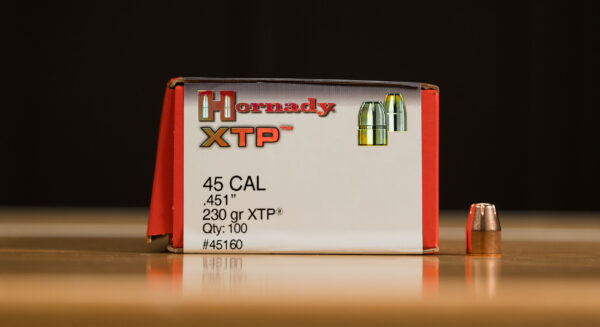
I was quite pleased with my first experience using Ramshot Silhouette. It flowed smoothly through the Brass Smith powder measure and worked well with both the 185 and the 230 grain XTP bullets, producing great velocity. This rates as another powder well-suited for use with a progressive press since it flows so smoothly through the measure. The SD figure of 12 fps from my 5” Kimber 1911 with the 230 grain Hornady bullet was particularly satisfying. The powder is obviously well suited for use in the .45 ACP.
Results
We looked at muzzle velocity, standard deviation, extreme spread, energy, and added power factor (PF). PF is mostly used in the world of IPSC competitive shooting and is used to determine major and minor class cartridges. Minor class cartridges produce less recoil and shot to shot recovery times are noticeably quicker. Depending on the competition type, a power factor of 160 or 170 is required for major class. All of the loads we tested easily exceed that requirement. The 200 grain 10mm, not surprisingly, produced the highest power factor of our loads.
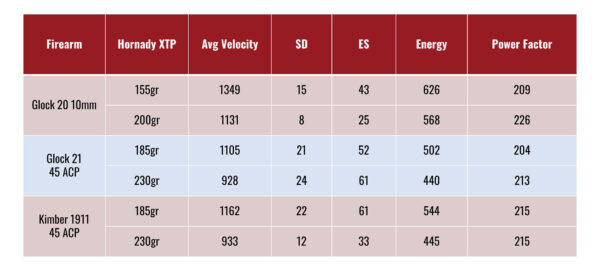
10mm Results
Our 10mm loads confirmed what we knew about the 10mm, that it is capable of significantly higher velocities than the .45 ACP can produce, even with +P loads. The high velocity leads to high ft.-lbs. of energy figures and a flatter trajectory, making downrange hits easier and downrange bullet performance better.
The 155 grain XTP was our speed champ in this project yielding 1349 fps, a tight SD of 15 fps, and producing an excellent energy figure of 626 ft lbs at the muzzle! This brings .357 magnum type velocity to the high capacity semi-auto platform of the GLOCK pistol. Impressive!
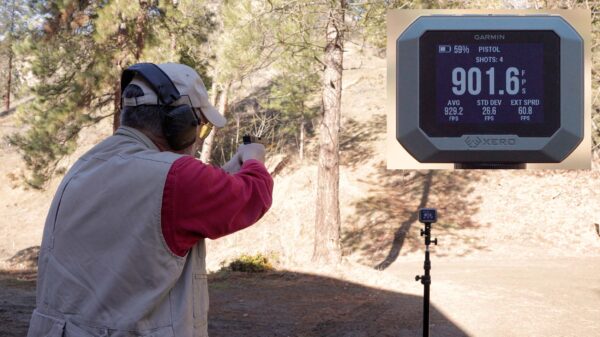
The 200 grain XTP easily reached the 1,100 fps range and recorded an exceptionally tight SD figure of only 8 fps. To me, this appears to be a fine load, particularly for use in the great outdoors.
.45 ACP+P Results
The 185 grain XTP load with a maximum charge of Ramshot Silhouette might surprise some people who consider the old .45 ACP as an 800 fps cartridge — it yielded an honest 1162 fps from my 5” Kimber! The same load exceeded 1,100 fps with the 4.6” GLOCK as well. Both of those velocities kept the ft.-lbs. of energy up at 500+ fps, which is well above normal .45 ACP levels. That’s one reason I like 185 grain bullets for everyday carry in my 1911.
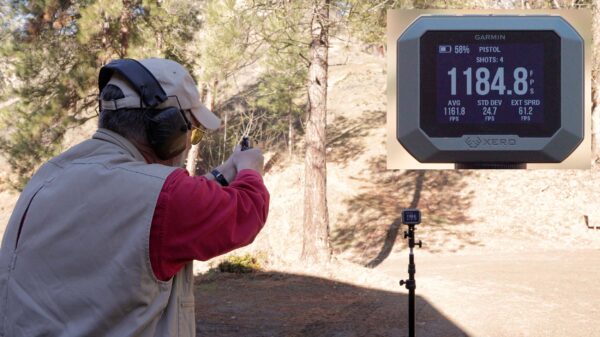
The max load of Ramshot Silhouette produced about 100 fps more velocity at the muzzle than a standard 230 grain factory load. It also recorded a nice tight standard deviation of 12, indicating that Ramshot Silhouette is indeed a good choice for the .45 ACP.
Shooting Impressions
First off—there’s no doubt about it, the 10mm and .45 ACP are the heavy hitters of the defensive semi-auto pistol world. Yes, bigger, more powerful cartridges are available, but the 10mm and the .45 are at the top of the list for common, easy-to-carry handguns with readily available factory ammunition. They shoot larger, heavier bullets than the .357’s, .38’s, and 9mm cartridges, but also produce significant recoil and are expensive to feed. I understand why some shooters steer away from them.
The max-loaded 10mm 155 grain XTP ammo sure got my attention! I judged the 155 grain bullet at a brisk 1349 fps to be the most difficult to control of all the loads tested. To shoot it well I had to be extra sure of my grip, my stance, and my follow-through. Fast follow-up shots could be readily made, it just took more work than with the other loads. That said, I think the 155 grain load would probably be my 10mm self-defense load of choice.
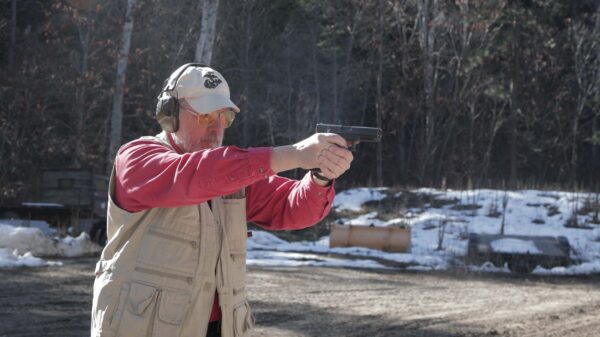
The 10mm 200 grain XTP is a bigger, heavier, deeper penetrating bullet, which would presumably make a better choice for dealing with a truculent bear, irritated moose, or other bellicose beast. Accurate No. 9 powered the 200 grain bullet to 1131 fps with an exceptionally tight SD of only 8 fps. That’s a match grade SD indicative of the powder quality and how well it works with the high-pressure 10mm cartridge.
My old friend, the .45 ACP, loaded to +P velocities, couldn’t match the 10mm for speed or power, but it’s still throwing a large diameter, heavy bullet at good velocity.
For ease of control, the 230 grain ammo seemed to have the least felt recoil. It felt like a big push rather than a harsh slap. Although I went back and forth between the GLOCK 21 and my Kimber 1911, I couldn’t decide which one was easier to use. The GLOCK has a wide grip which spreads out the impact to the shooter’s hand. The more narrow single stack 1911 fits my hand better —although I may be just a bit biased after 44 years of shooting a 1911. Either one is quite controllable.
To me, the 185 grain 1,162 fps load had a bit snappier recoil, but was still easily controllable from both the GLOCK 21 and the Kimber 1911. I am thoroughly impressed with the 544 ft.-lbs. of energy that load produced from the Kimber and would prefer that as a .45 ACP everyday carry load.
Head-to-Head
Taking a closer look at the pros and cons of both cartridges, the 10mm is obviously the more powerful of the two with higher velocity while still slinging bullets of serious size. It does appear to be the better choice against aggressive four-legged wildlife and is seen by some as a good alternative to large magnum revolvers. 10mm, however, is indeed more difficult to control than .45. This is not just from my own experience, but also indicated by the law enforcement agencies that dropped it in favor of other, gentler-shooting cartridges.
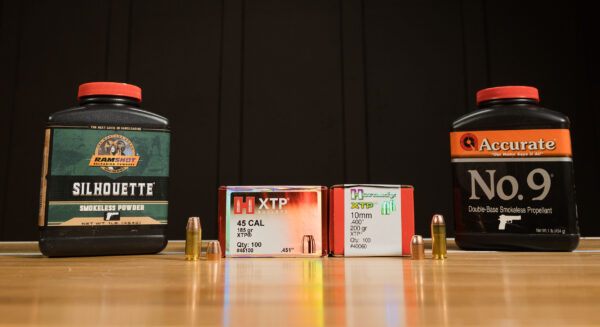
The .45 ACP continues the long legacy it has established through well over 100 years of service. Despite its size and power, it is a lower pressure cartridge and can be easily mastered with practice. The .45 ACP potentially offers less penetration than the 10mm, which can be an advantage in urban settings. Perhaps the biggest drawback of the .45 ACP is that it produces less power than the 10mm. If one is seeking a very powerful handgun, the 10mm is a better choice.
Conclusion
These two cartridges are at the top of the heap for readily available, sensible semi-automatic defensive pistols. They both have well established records and offer an advantage over smaller cartridges by striking a harder blow and potentially inflicting more damage for quicker incapacitation of an attacker. The downsides of all that power are heavier recoil, a strong muzzle blast, and expensive ammunition. (10mm and .45 ACP are more expensive than 9mm.)
Choosing between the two can be difficult as both are good choices. The 10mm seems particularly useful in a rural setting, where ranges may be longer and the chances of an animal attack are higher.
The .45 ACP is a bit less intense and may reduce penetration, making it my favored choice for urban carry. Penetration is highly dependent on bullet selection—FMJ bullets can produce tremendous penetration with either cartridge.
I’ve been a fan of the .45 ACP since the Marines issued me one over 40 years ago and see no reason to stop carrying one. It’s a favorite of mine, but I sure wouldn’t mind adding a 10mm for backwoods carry.
Get the Gear
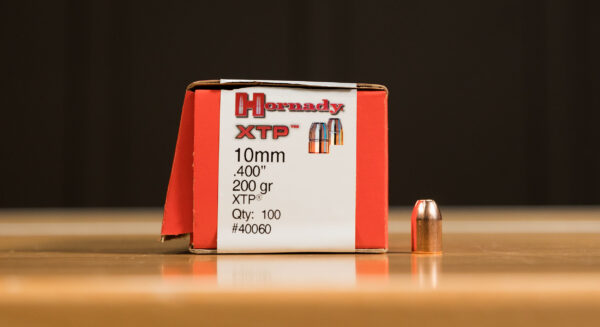
Hornady 10mm .400 Diameter 155 Grain XTP at Midsouth Shooters Supply
Hornady 10mm .400 Diameter 200 Grain XTP at Midsouth Shooters Supply
Hornady .45 Caliber .451 Diameter 185 Grain XTP at Midsouth Shooters Supply
Hornady .45 Caliber .451 Diameter 230 Grain XTP at Midsouth Shooters Supply
Hornady American Gunner 10mm Auto 155 Grain XTP Ammunition at Midsouth Shooters Supply
Hornady American Gunner 45 Auto 185 Grain XTP Ammunition at Midsouth Shooters Supply
Hornady .45 ACP + P 230 Grain XTP Jacketed Hollow Point Ammunition at Midsouth Shooters Supply
Accurate No. 9 Smokeless Powder at Midsouth Shooters Supply
Ramshot Silhouette Pistol Powder at Midsouth Shooters Supply
Hornady .45 ACP Unprimed Pistol Brass at Midsouth Shooters Supply
Starline 10mm Auto Unprimed Pistol Brass at Midsouth Shooter Supply
CCI #300 Large Pistol Primers at Midsouth Shooters Supply
RCBS .45 ACP Carbide Taper Crimp 3 Die Set at Midsouth Shooters Supply
Hornady .45 ACP Taper Crimp Die at Midsouth Shooters Supply
Hornady 10mm/40S&W Series II Handgun 3 Die Set With Zip Spindle at Midsouth Shooters Supply
Lyman Brass Smith All-American 8-Station Turret Press Reloading Kit at Midsouth Shooters Supply
Lyman Brass Smith Powder Measure at Midsouth Shooters Supply
Don’t miss out on Ultimate Reloader updates, make sure you’re subscribed!
Thanks,
Guy Miner
